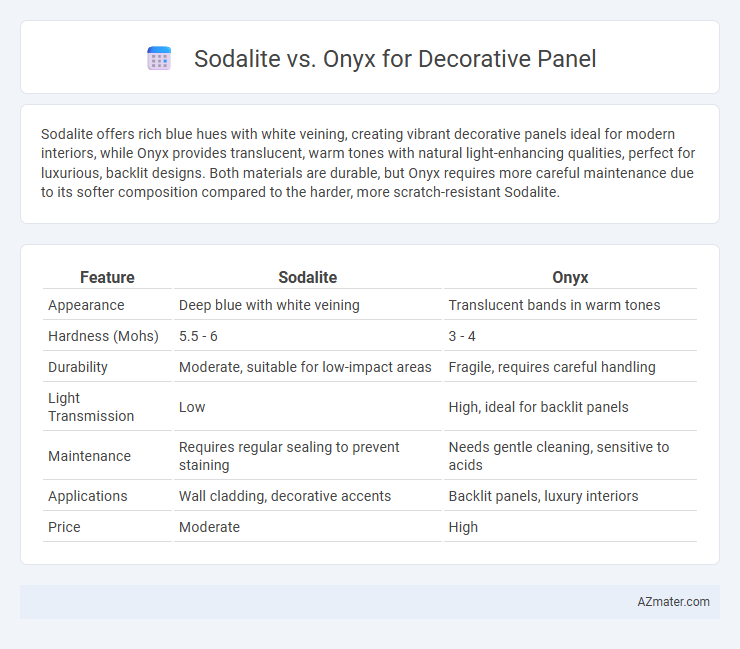Sodalite offers rich blue hues with white veining, creating vibrant decorative panels ideal for modern interiors, while Onyx provides translucent, warm tones with natural light-enhancing qualities, perfect for luxurious, backlit designs. Both materials are durable, but Onyx requires more careful maintenance due to its softer composition compared to the harder, more scratch-resistant Sodalite.
Table of Comparison
| Feature | Sodalite | Onyx |
|---|---|---|
| Appearance | Deep blue with white veining | Translucent bands in warm tones |
| Hardness (Mohs) | 5.5 - 6 | 3 - 4 |
| Durability | Moderate, suitable for low-impact areas | Fragile, requires careful handling |
| Light Transmission | Low | High, ideal for backlit panels |
| Maintenance | Requires regular sealing to prevent staining | Needs gentle cleaning, sensitive to acids |
| Applications | Wall cladding, decorative accents | Backlit panels, luxury interiors |
| Price | Moderate | High |
Introduction to Sodalite and Onyx
Sodalite, a rich royal blue mineral with white veining, is prized for its vibrant color and unique patterns, making it an excellent choice for decorative panels that demand a striking appearance. Onyx, characterized by its translucency and layered bands of various colors including white, brown, and green, offers an elegant and luxurious look that enhances interior spaces with natural light effects. Both sodalite and onyx bring distinct aesthetic qualities and visual depth to decorative panels, influencing design choices based on color intensity and texture preferences.
Origin and Geological Formation
Sodalite, primarily sourced from Brazil, Canada, and Namibia, forms through the crystallization of igneous rocks in feldspathoid-rich environments, resulting in rich blue hues ideal for decorative panels. Onyx, originating from regions such as Pakistan, Mexico, and Brazil, develops through the layering of calcite or aragonite in caves via slow deposition of mineral-rich waters, creating distinct banded patterns perfect for elegant panel designs. The contrasting geological origins influence their physical properties and aesthetic appeal, making sodalite vibrant and onyx uniquely translucent for interior decoration.
Visual Appearance and Color Variations
Sodalite decorative panels showcase rich blue tones with white veining, creating a striking, vibrant contrast ideal for modern and bold interior designs. Onyx panels offer a translucent quality with warm hues ranging from creamy whites to amber and honey, allowing backlighting to enhance its luxurious and elegant appeal. The choice between Sodalite and Onyx depends on desired ambiance and lighting, with Sodalite providing deep, intense color and Onyx delivering warmth and luminosity.
Physical Properties and Durability
Sodalite features a rich blue coloration with white veining, exhibiting a Mohs hardness of about 5.5 to 6, making it moderately durable yet more prone to scratches compared to Onyx. Onyx presents a translucent appearance with layered bands, and its Mohs hardness ranges from 6 to 7, providing greater resistance to wear and impact, which enhances its suitability for high-traffic decorative panels. Both stones require sealing to prevent staining, but Onyx's higher density and resistance to abrasion make it preferable for long-lasting decorative installations.
Applications in Decorative Panels
Sodalite enhances decorative panels with its deep blue hues and white veining, creating striking visual contrasts ideal for luxurious interiors and accent walls. Onyx offers translucent properties and rich color variations, making it suitable for backlit panels in high-end decorative applications. Both stones provide unique textures and patterns that elevate aesthetic appeal in residential and commercial decorative paneling.
Maintenance and Care Requirements
Sodalite decorative panels require gentle cleaning with mild soap and water to maintain their vibrant blue and white patterns, avoiding acidic or abrasive cleaners that can dull the surface. Onyx panels demand more delicate care due to their soft, porous nature, necessitating regular sealing and immediate cleanup of spills to prevent staining and etching. Both materials benefit from professional polishing every few years to preserve their natural luster and structural integrity in decorative applications.
Cost Comparison and Availability
Sodalite panels typically cost less than onyx due to its greater abundance and easier quarrying processes, making it a budget-friendly option for decorative applications. Onyx is rarer and more challenging to source, resulting in higher prices and limited availability in the market. Availability of sodalite is widespread, while onyx is often reserved for premium projects due to its exclusivity and cost.
Design Trends and Aesthetic Appeal
Sodalite's deep blue hues with white veining create a striking, modern aesthetic that aligns with contemporary design trends emphasizing bold color contrasts and natural patterns. Onyx offers a translucent quality with warm, earthy tones ideal for backlit decorative panels, enhancing luxury and ambiance in interior spaces. Designers prefer sodalite for vibrant, statement-making surfaces, while onyx is favored for its elegant, glowing effect that adds depth and sophistication.
Environmental Impact and Sustainability
Sodalite, a relatively abundant mineral, has a lower environmental impact due to its simpler extraction processes and minimal chemical treatments compared to Onyx, which often requires extensive quarrying and resin enhancements, increasing ecological footprint. Onyx panels, prized for their translucency and aesthetic appeal, tend to involve more energy-intensive fabrication methods and generate higher waste levels, challenging sustainability goals in decorative applications. Choosing Sodalite for decorative panels supports eco-friendlier sourcing and reduced carbon emissions, aligning with environmental sustainability standards in interior design.
Choosing Between Sodalite and Onyx for Your Project
Sodalite offers rich blue hues with white veining, making it an ideal choice for decorative panels that seek a vibrant, bold statement. Onyx provides a translucent quality with warm tones, perfect for backlit panels requiring sophisticated elegance and depth. Selecting between sodalite and onyx depends on your desired aesthetic--choose sodalite for striking color contrast and onyx for luminous, luxurious effects.

Infographic: Sodalite vs Onyx for Decorative Panel
 azmater.com
azmater.com